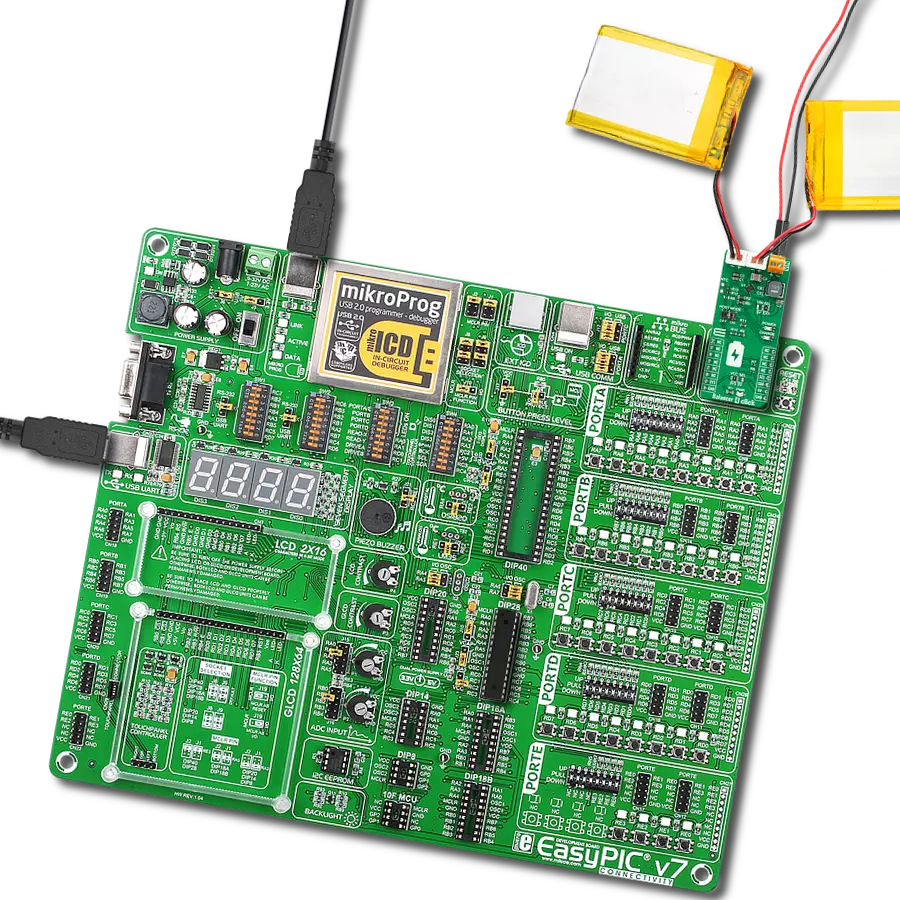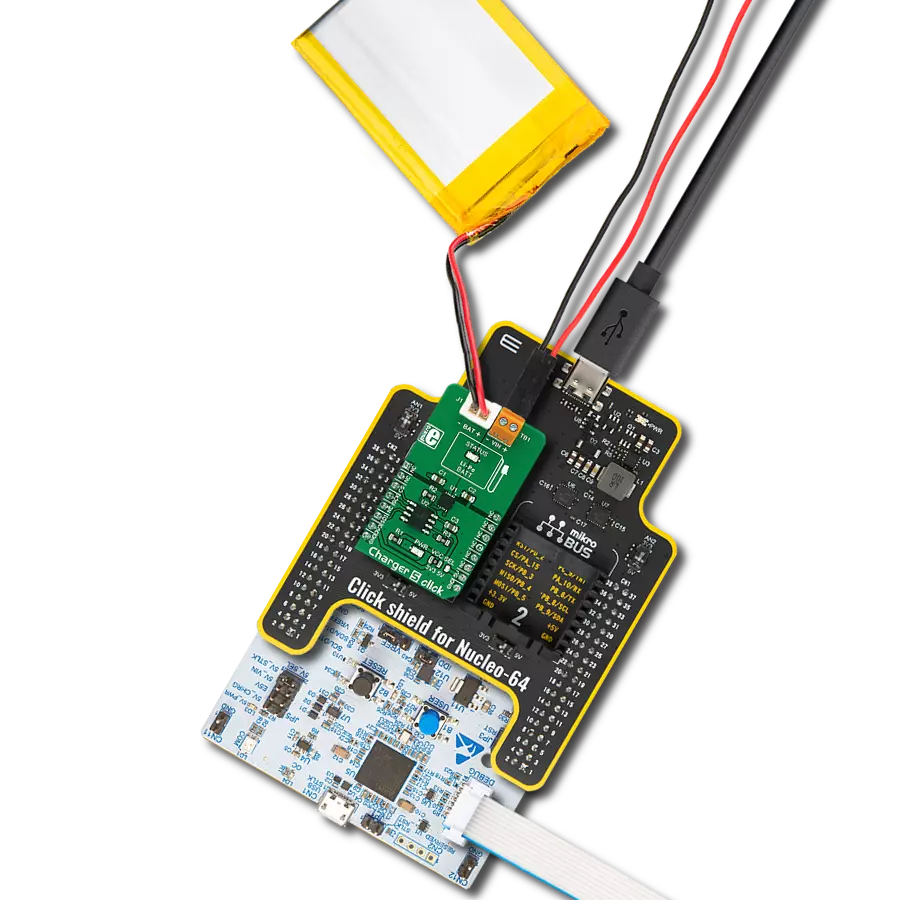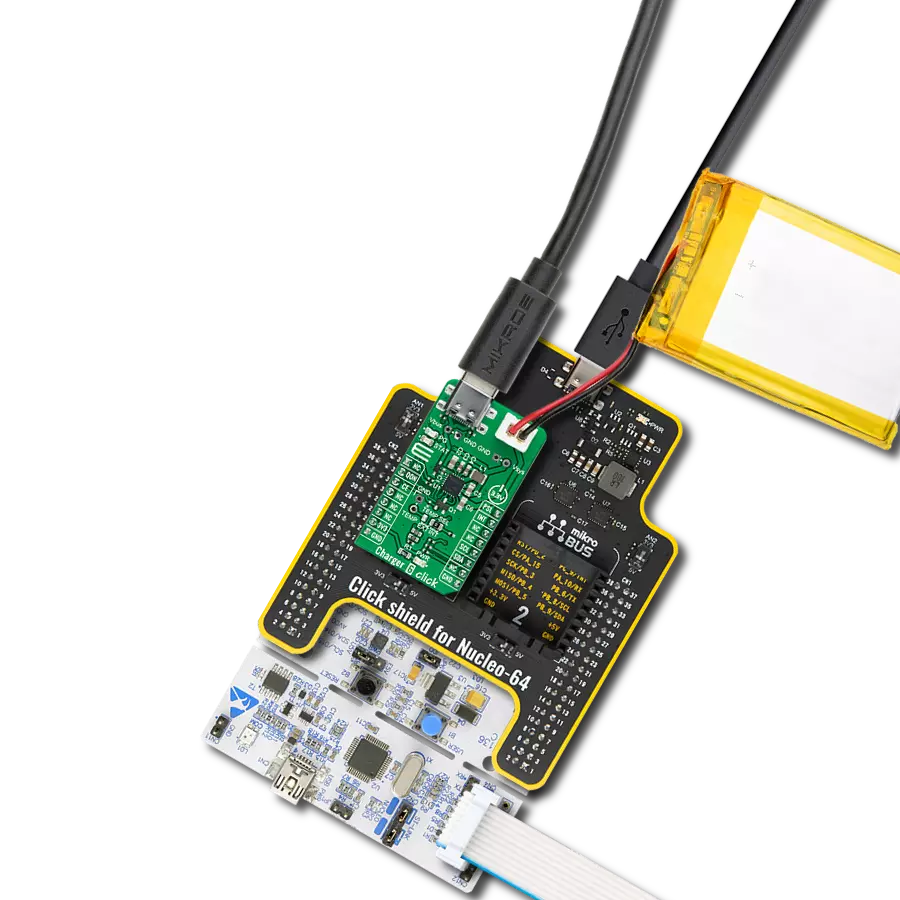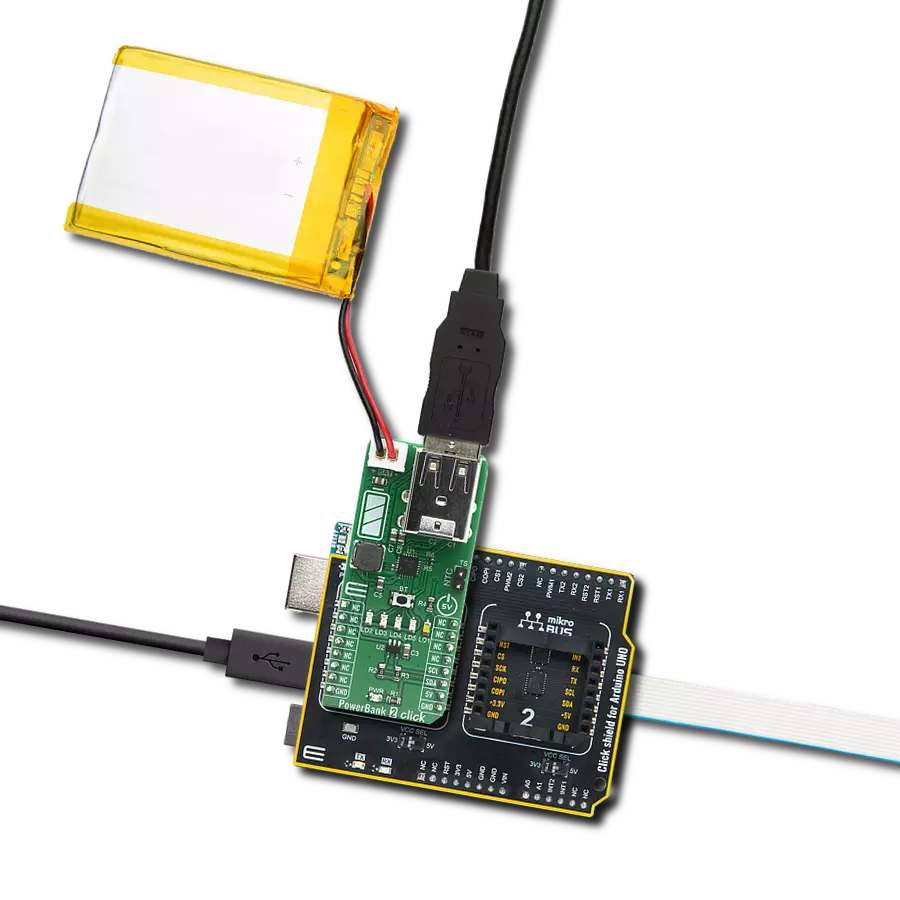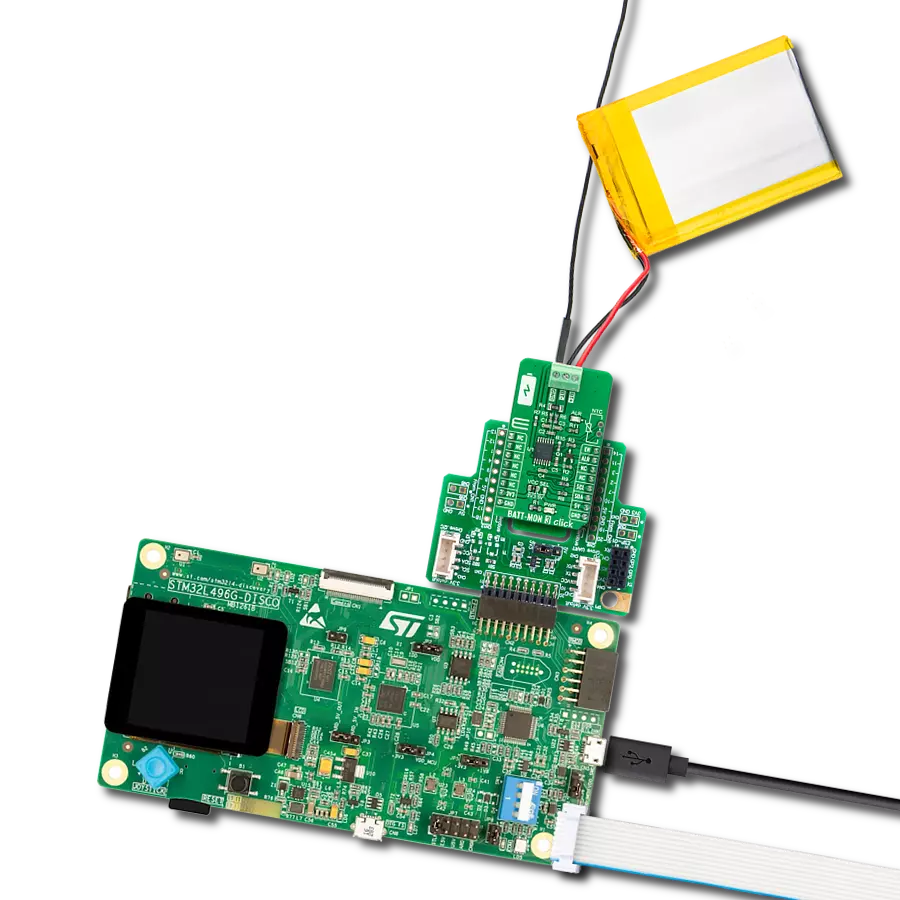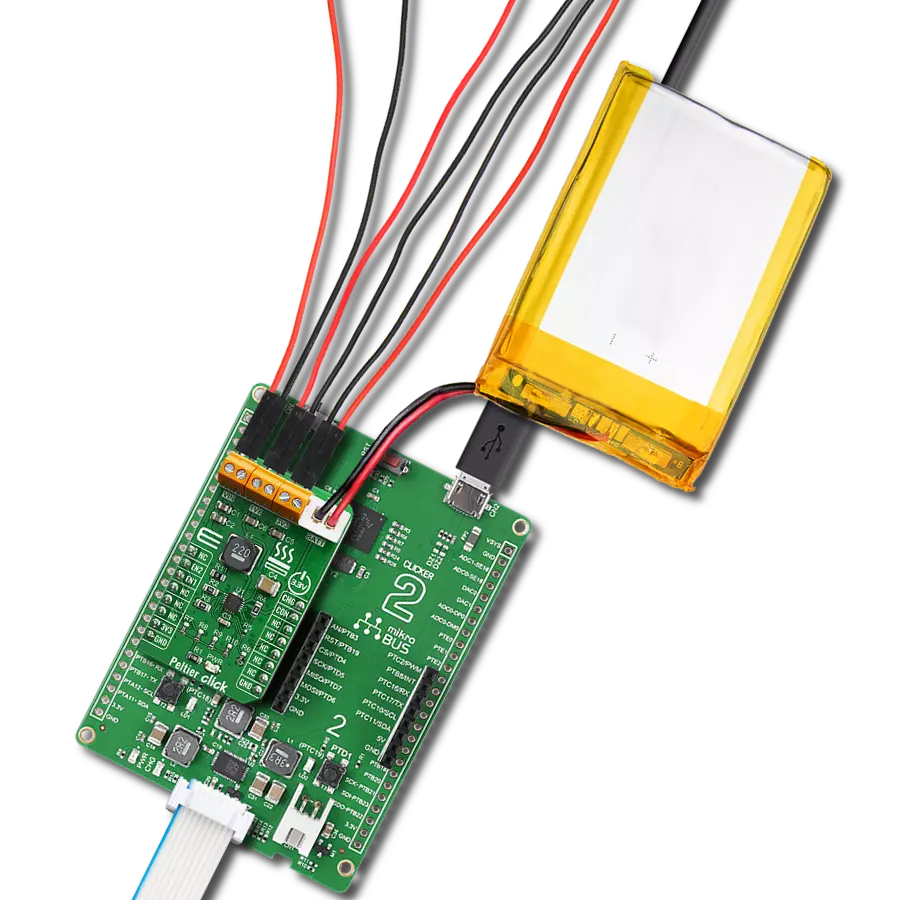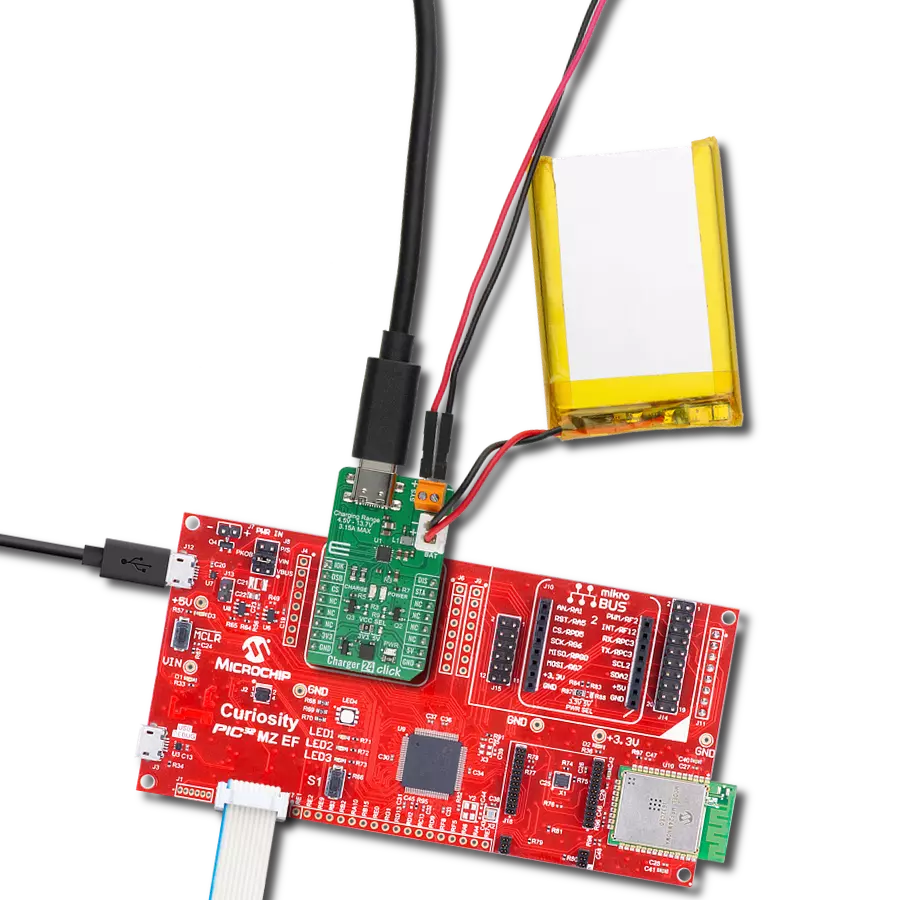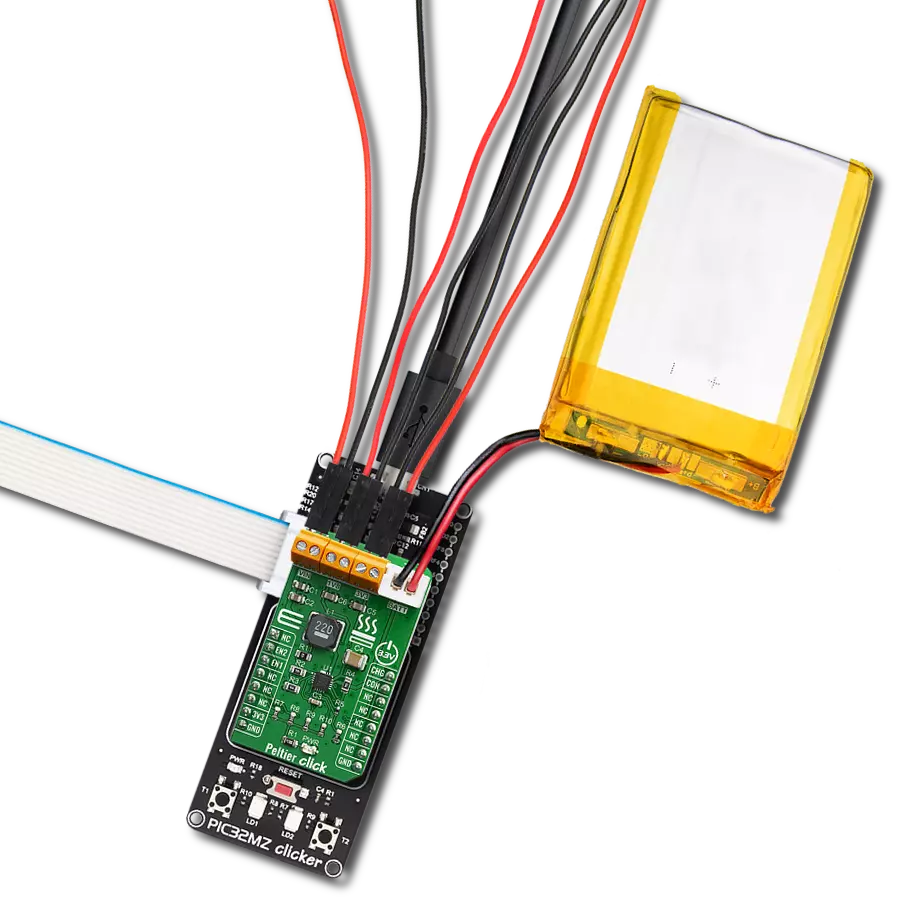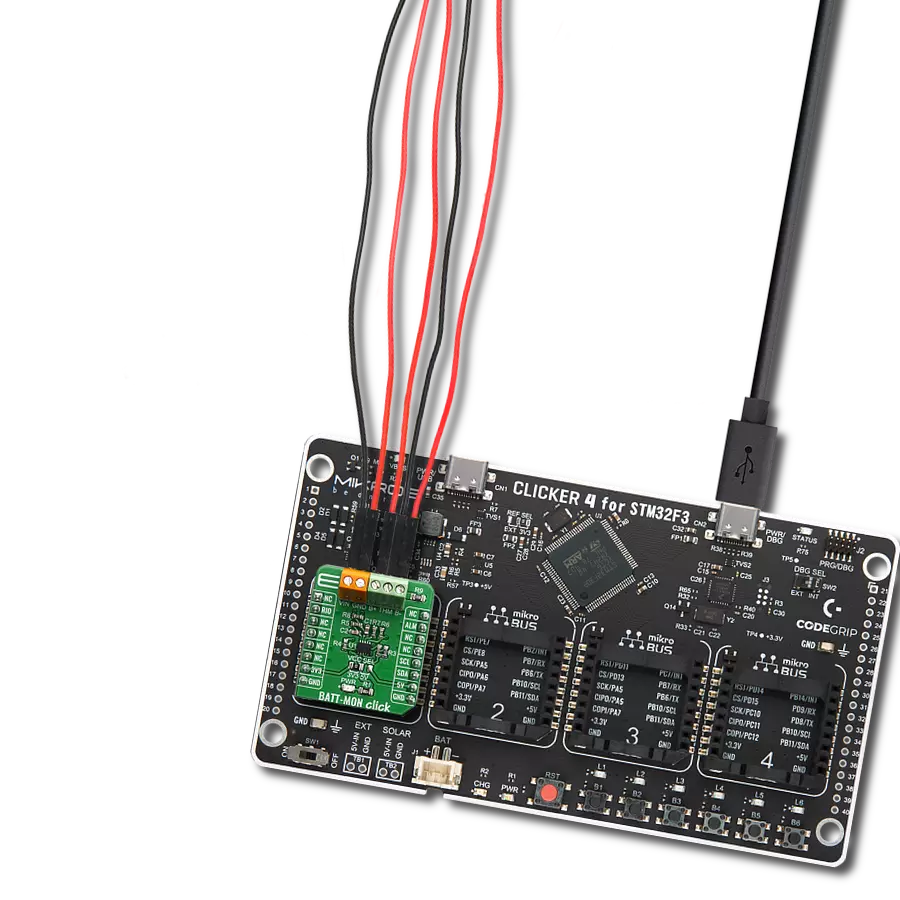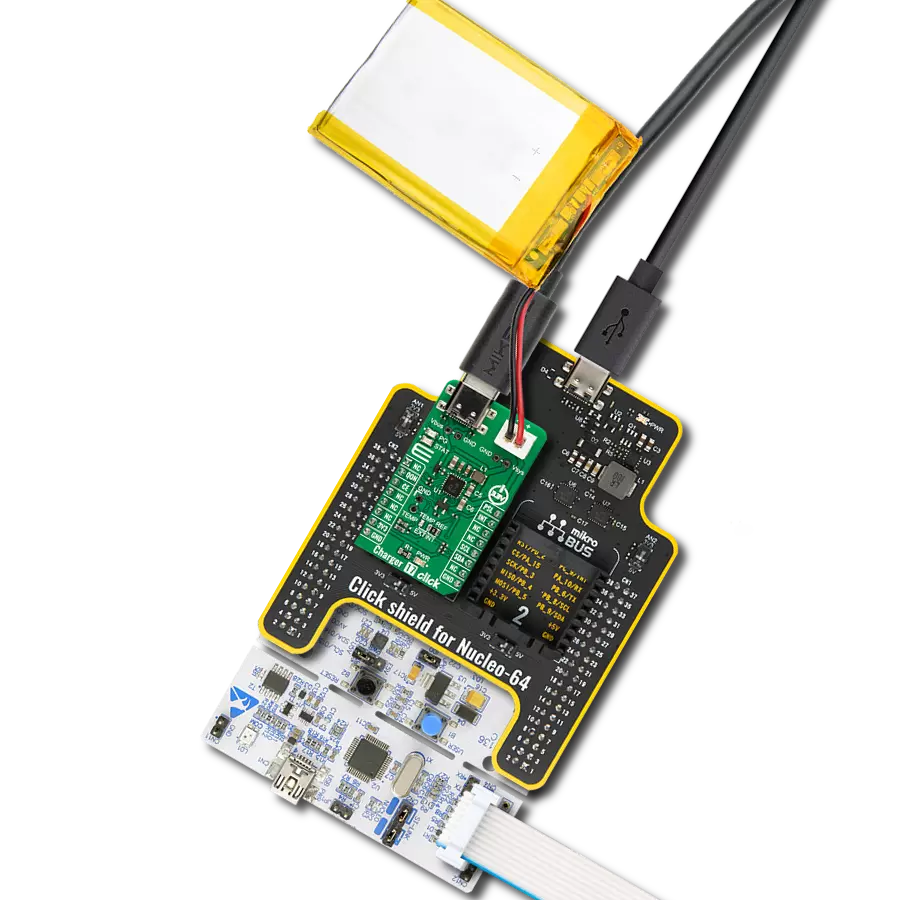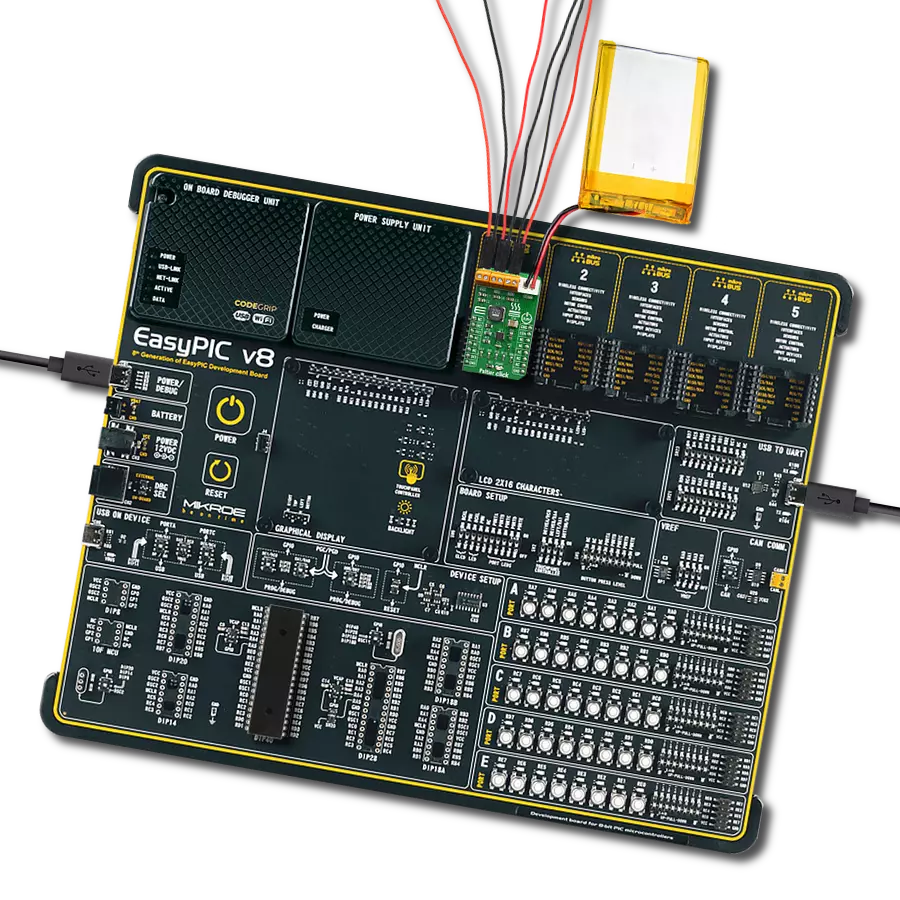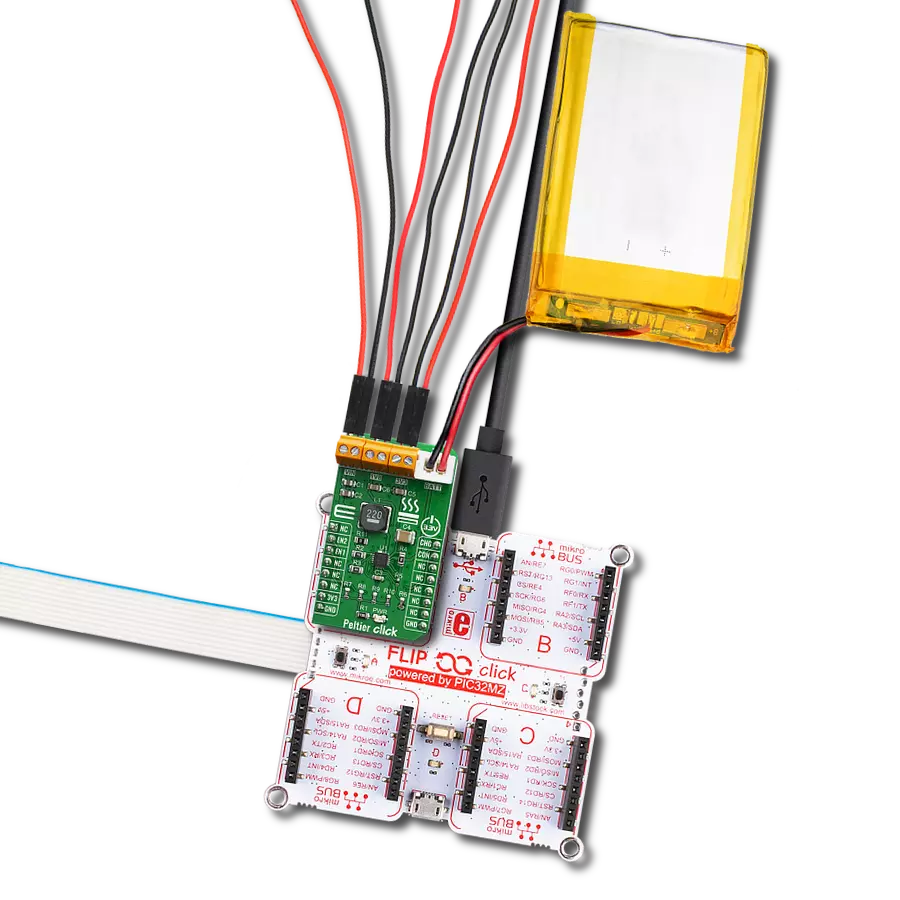Maintain the charge balance between batteries
A
A
Hardware Overview
How does it work?
Balancer 4 Click is based on the MP2672A, a highly integrated and flexible switch-mode battery charger for two-cell Lithium-Ion batteries in series from Monolithic Power Systems (MPS). The MP2672A features a cell balance function that monitors the voltage across each cell and equalizes them if the difference exceeds the mismatch threshold. It features up to 2A of programmable charge current for batteries with two cells in series, alongside protections like battery temperature monitoring, programmable charging safety timer protection, JEITA-compliant battery NTC monitoring, cell over-voltage protection (OVP), thermal regulation, and thermal shutdown. The MP2672A has a narrow voltage DC (NVDC) power structure. It automatically detects the battery voltage and charges it in three phases: pre-charge, constant current, and voltage charge. With a deeply discharged battery, the MP2672A regulates the system output to a minimum voltage level, which powers the system
instantly while simultaneously charging the battery via integrated FET. It also offers flexible new charging cycle initiation compatible with Standalone mode and Host-control mode of operation selectable through an onboard switch labeled as HOST SEL. Diverse and robust protections include a thermal regulation loop to decrease the charge current if the junction temperature exceeds the thermal loop threshold and battery temperature protection compliant with JEITA standards. Other safety features include input over-voltage protection (OVP), battery OVP, thermal shutdown, battery temperature monitoring, and a configurable backup timer to prevent prolonged charging of a dead battery. Balancer 4 Click communicates with MCU using the standard I2C 2-Wire interface to read data and configure settings, supporting a Standard Mode operation up to 100kHz. It also has two LED indicators, red and green, marked with CHARGE and POWER, which can visually show
the existence of a good power supply to the MP2672A and the active status of the battery charging process. Also, an NTC function is available for temperature-qualified charging, where the MP2672A continuously monitors the battery’s temperature by measuring the voltage on the onboard NTC header pins. This Click board™ can operate with both 3.3V and 5V logic voltage levels selected via the VCC SEL jumper. It allows both 3.3V and 5V capable MCUs to use the communication lines properly. Additionally, there is a possibility for the MP2672A power supply selection via jumper labeled as VIN SEL to supply the MP2672A from an external power supply terminal in the range from 4V to 5.75V or with 5V voltage level from mikroBUS™ power rail. However, the Click board™ comes equipped with a library containing easy-to-use functions and an example code that can be used, as a reference, for further development.

Features overview
Development board
EasyPIC v7 is the seventh generation of PIC development boards specially designed to develop embedded applications rapidly. It supports a wide range of 8-bit PIC microcontrollers from Microchip and has a broad set of unique functions, such as a powerful onboard mikroProg programmer and In-Circuit debugger over USB-B. The development board is well organized and designed so that the end-user has all the necessary elements in one place, such as switches, buttons, indicators, connectors, and others. With four different connectors for each port, EasyPIC v7 allows you to connect accessory boards, sensors, and custom electronics more efficiently than ever. Each part of
the EasyPIC v7 development board contains the components necessary for the most efficient operation of the same board. An integrated mikroProg, a fast USB 2.0 programmer with mikroICD hardware In-Circuit Debugger, offers many valuable programming/debugging options and seamless integration with the Mikroe software environment. Besides it also includes a clean and regulated power supply block for the development board. It can use various external power sources, including an external 12V power supply, 7-23V AC or 9-32V DC via DC connector/screw terminals, and a power source via the USB Type-B (USB-B) connector. Communication options such as
USB-UART and RS-232 are also included, alongside the well-established mikroBUS™ standard, three display options (7-segment, graphical, and character-based LCD), and several different DIP sockets. These sockets cover a wide range of 8-bit PIC MCUs, from PIC10F, PIC12F, PIC16F, PIC16Enh, PIC18F, PIC18FJ, and PIC18FK families. EasyPIC v7 is an integral part of the Mikroe ecosystem for rapid development. Natively supported by Mikroe software tools, it covers many aspects of prototyping and development thanks to a considerable number of different Click boards™ (over a thousand boards), the number of which is growing every day.
Microcontroller Overview
MCU Card / MCU

Architecture
PIC
MCU Memory (KB)
32
Silicon Vendor
Microchip
Pin count
28
RAM (Bytes)
3800
You complete me!
Accessories
Li-Polymer Battery is the ideal solution for devices that demand a dependable and long-lasting power supply while emphasizing mobility. Its compatibility with mikromedia boards ensures easy integration without additional modifications. With a voltage output of 3.7V, the battery meets the standard requirements of many electronic devices. Additionally, boasting a capacity of 2000mAh, it can store a substantial amount of energy, providing sustained power for extended periods. This feature minimizes the need for frequent recharging or replacement. Overall, the Li-Polymer Battery is a reliable and autonomous power source, ideally suited for devices requiring a stable and enduring energy solution. You can find a more extensive choice of Li-Polymer batteries in our offer.
Used MCU Pins
mikroBUS™ mapper
Take a closer look
Click board™ Schematic

Step by step
Project assembly
Track your results in real time
Application Output
1. Application Output - In Debug mode, the 'Application Output' window enables real-time data monitoring, offering direct insight into execution results. Ensure proper data display by configuring the environment correctly using the provided tutorial.

2. UART Terminal - Use the UART Terminal to monitor data transmission via a USB to UART converter, allowing direct communication between the Click board™ and your development system. Configure the baud rate and other serial settings according to your project's requirements to ensure proper functionality. For step-by-step setup instructions, refer to the provided tutorial.

3. Plot Output - The Plot feature offers a powerful way to visualize real-time sensor data, enabling trend analysis, debugging, and comparison of multiple data points. To set it up correctly, follow the provided tutorial, which includes a step-by-step example of using the Plot feature to display Click board™ readings. To use the Plot feature in your code, use the function: plot(*insert_graph_name*, variable_name);. This is a general format, and it is up to the user to replace 'insert_graph_name' with the actual graph name and 'variable_name' with the parameter to be displayed.

Software Support
Library Description
This library contains API for Balancer 4 Click driver.
Key functions:
balancer4_write_registerThis function writes a desired data byte to the selected register by using I2C serial interface.balancer4_write_and_verify_registerThis function writes a desired data byte to the selected register and verifies if it is written correctly by reading it.balancer4_read_registerThis function reads a data byte from the selected register by using I2C serial interface.
Open Source
Code example
The complete application code and a ready-to-use project are available through the NECTO Studio Package Manager for direct installation in the NECTO Studio. The application code can also be found on the MIKROE GitHub account.
/*!
* @file main.c
* @brief Balancer4 Click example
*
* # Description
* This example demonstrates the use of Balancer 4 Click board by configuring
* the Click board for charging and then reading the status and fault registers.
*
* The demo application is composed of two sections :
*
* ## Application Init
* Initializes the driver and configures the Click board for charging.
*
* ## Application Task
* Reads and displays the status and fault registers on the USB UART every 500ms approximately.
*
* @author Stefan Filipovic
*
*/
#include "board.h"
#include "log.h"
#include "balancer4.h"
static balancer4_t balancer4;
static log_t logger;
void application_init ( void )
{
log_cfg_t log_cfg; /**< Logger config object. */
balancer4_cfg_t balancer4_cfg; /**< Click config object. */
/**
* Logger initialization.
* Default baud rate: 115200
* Default log level: LOG_LEVEL_DEBUG
* @note If USB_UART_RX and USB_UART_TX
* are defined as HAL_PIN_NC, you will
* need to define them manually for log to work.
* See @b LOG_MAP_USB_UART macro definition for detailed explanation.
*/
LOG_MAP_USB_UART( log_cfg );
log_init( &logger, &log_cfg );
log_info( &logger, " Application Init " );
// Click initialization.
balancer4_cfg_setup( &balancer4_cfg );
BALANCER4_MAP_MIKROBUS( balancer4_cfg, MIKROBUS_1 );
if ( I2C_MASTER_ERROR == balancer4_init( &balancer4, &balancer4_cfg ) )
{
log_error( &logger, " Communication init." );
for ( ; ; );
}
if ( BALANCER4_ERROR == balancer4_default_cfg ( &balancer4 ) )
{
log_error( &logger, " Default configuration." );
for ( ; ; );
}
log_info( &logger, " Application Task " );
}
void application_task ( void )
{
uint8_t status, fault;
if ( BALANCER4_OK == balancer4_read_register ( &balancer4, BALANCER4_REG_STATUS, &status ) )
{
log_printf ( &logger, "\r\n - STATUS - \r\n", status );
log_printf ( &logger, " Battery status: " );
if ( status & BALANCER4_STATUS_BATTERY_MISSING )
{
log_printf ( &logger, "missing\r\n" );
}
else
{
log_printf ( &logger, "present\r\n" );
log_printf ( &logger, " Charging status: " );
switch ( status & BALANCER4_STATUS_CHG_STAT_MASK )
{
case BALANCER4_STATUS_NOT_CHARGING:
{
log_printf ( &logger, "not charging\r\n" );
break;
}
case BALANCER4_STATUS_PRE_CHARGE:
{
log_printf ( &logger, "pre-charge\r\n" );
break;
}
case BALANCER4_STATUS_CONSTANT_CHARGE:
{
log_printf ( &logger, "constant current or constant voltage charge\r\n" );
break;
}
case BALANCER4_STATUS_CHARGING_COMPLETE:
{
log_printf ( &logger, "charging complete\r\n" );
break;
}
}
}
}
if ( BALANCER4_OK == balancer4_read_register ( &balancer4, BALANCER4_REG_FAULT, &fault ) )
{
if ( fault )
{
log_printf ( &logger, "\r\n - FAULT - \r\n" );
if ( fault & BALANCER4_FAULT_WD )
{
log_printf ( &logger, " The watchdog timer has expired\r\n" );
}
if ( fault & BALANCER4_FAULT_INPUT )
{
log_printf ( &logger, " Input OVP has occured\r\n" );
}
if ( fault & BALANCER4_FAULT_THERMAL_SD )
{
log_printf ( &logger, " Thermal shutdown\r\n" );
}
if ( fault & BALANCER4_FAULT_TIMER )
{
log_printf ( &logger, " The safety timer has expired\r\n" );
}
if ( fault & BALANCER4_FAULT_BAT )
{
log_printf ( &logger, " Battery OVP has occured\r\n" );
}
switch ( fault & BALANCER4_FAULT_NTC_MASK )
{
case BALANCER4_FAULT_NTC_COLD:
{
log_printf ( &logger, " An NTC cold fault has occured\r\n" );
break;
}
case BALANCER4_FAULT_NTC_COOL:
{
log_printf ( &logger, " An NTC cool fault has occured\r\n" );
break;
}
case BALANCER4_FAULT_NTC_WARM:
{
log_printf ( &logger, " An NTC warm fault has occured\r\n" );
break;
}
case BALANCER4_FAULT_NTC_HOT:
{
log_printf ( &logger, " An NTC hot fault has occured\r\n" );
break;
}
}
}
}
Delay_ms ( 500 );
}
int main ( void )
{
/* Do not remove this line or clock might not be set correctly. */
#ifdef PREINIT_SUPPORTED
preinit();
#endif
application_init( );
for ( ; ; )
{
application_task( );
}
return 0;
}
// ------------------------------------------------------------------------ END
